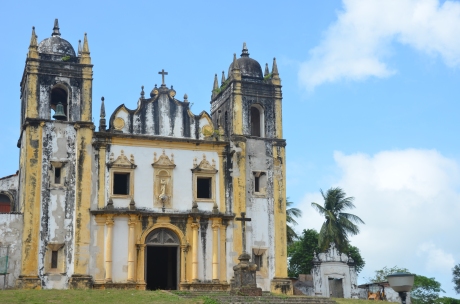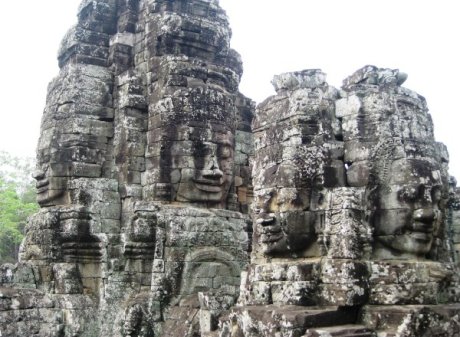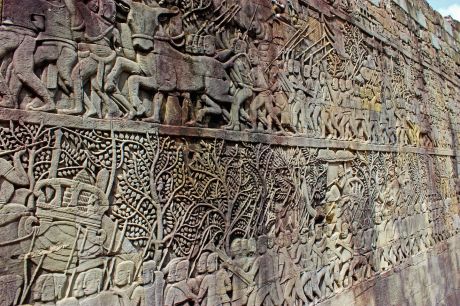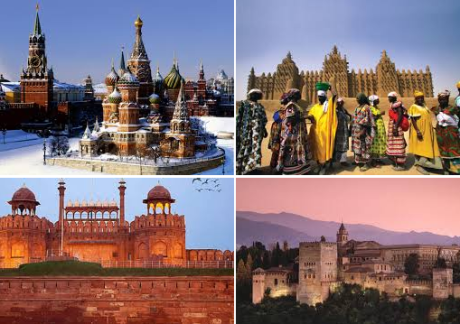Civilizations of the Tropical Rainforest Biome
13 October 2015
Tuesday
Case Studies in Civilization:
Civilizations of the Tropical Rainforest Biome
In an earlier post, Riparian Civilizations, I outlined some of the commonalities of civilizations that had their origins in fertile river valleys — most notably the civilizations of Mesopotamia, i.e., the Fertile Crescent bounded by the Tigris and Euphrates rivers, the civilization of ancient Egypt, based on the annual flooding of the Nile, the Yellow River Valley civilization (the source of Chinese civilization), and the Indus Valley civilization (the source of civilization in the Indian subcontinent).
While these early civilizations occurred within the equatorial belt, i.e., in the tropics, they were not in tropical rain forests. The biome of a river valley can vary according to rainfall and temperature, even within the tropics. The Congo basin is dominated by tropical rain forests, while the Nile Valley is a canyon that cuts through a desert biome, and so shares properties of the desert and of the river. Mesopotamia has (or had) extensive wetlands fed by its rivers, which became the domain of the Marsh Arabs, who adopted a unique way of life specially suited to this environment. But, again, this was not a tropical rain forest, though Mesopotamia lies in the tropics.

The Iberian civilization of Portugal was transplanted to the tropics of Brazil, and eventually acclimated to the region, but not without descent with modification.
In additional to spatial distinctions among biomes, i.e., recognizing biomes confined to a given geographical region, temporal distinctions must also be made, both because of changing biomes over time due to climatological shifts, and changing human abilities to inhabit and settle a given biome, largely a function of increasing technology. Thus a distinction can be made between civilizations that originate within a given biome and civilizations that acclimate to a given biome. The colonial civilizations that came to Brazil in the early modern period, and to the Congo and SE Asia in the nineteenth century, were transplanted civilizations that adapted to and acclimated to a tropical rainforest biome, and can legitimately be called rainforest civilizations, but none of these civilizations originated in a tropical rainforest biome.

From Frederick Catherwood’s Views of Ancient Monuments, 1844, a temple at Tulum, in present-day Mexico.
We are fortunate to have the terrestrial example of two civilizations of completely independent origins, both of the tropical rainforest biome, though in opposite hemispheres: Mayan civilization in the western hemisphere and Khmer civilization in the eastern hemisphere. In the best tradition of settled agricultural civilizations, both the Mayans and the Khmer left monumental architecture. Indeed, the pyramids of Central America and the temples of Angkor Wat, made picturesque by their reclamation by the tropical rain forest that was the incubator of these civilizations, overgrown by vines and their foundations tumbled by the roots of gigantic trees, have become iconic tourist draws in their respective regions of the world. The riches of past civilizations have now been passed down as a kind of legacy to the present peoples, mostly ethnically continuous with the peoples who built these civilizations, whose descendants now derive a modest income from tourist traffic.

Angkor Wat from Voyage d’exploration en Indo-Chine by Francis Garnier, with illustrations by Louis Delaporte (1873).
We do not yet possess a complete seriation of civilization in the western hemisphere. We know that maize cultivation began in the Rio Balsas valley in what is now southern Mexico, a semi-arid tropical biome (and the native range of the teosinte grasses that were transformed by ancient agriculturalists into maize), and so may be assimilated to the paradigm of riparian civilizations. Mayan civilization, however, was concentrated in the rain forests of Central America. How exactly Mayan civilization was related to its northern neighbor, thousands of years its senior, is not yet fully understood.

Early forms of maize, derived from the teosinte grasses of the Rio Balsas Valley in southern Mexican, a region contiguous with the tropical rain forests of Central America.
Genetic sequencing of maize is a source of recent knowledge about the origins of maize, hence of origins of settled agriculturalism in the western hemisphere, but this work is ongoing at present. Moreover, while maize was an important crop for the Maya, and the Mayan corn god plays an important role in Mayan mythology, it was not the sole staple of the Maya. Maize was one of the “Three Sisters”, along with squash and beans, which together constituted a nutritionally balanced diet, and the cultivation of these crops together was ecologically sustainable due to complementary biochemical interaction with the soil.
We also lack a complete seriation of civilization in Asia, of which a seriation of civilization in Indochina would be an appendage. Khmer civilization rose from a pre-existing context of minor kingdoms in Indochina, and seems to draw upon both Indian and Chinese civilizational origins (though primarily Indian and Hindu), though it should be noted that recent archaeological work in the Malay archipelago suggest that civilization may have independently originated on the island of Java as well (depending upon the antiquity of Gunung Padang), in which case Khmer civilization would constitute a florid syncretism of Indian, Chinese, and Javanese cultural antecedents. Indeed, this is true whether or not civilization independently arose in Java, as the Khmer civilization is many thousands of years younger than these other examples.
The biome in which a civilization arises not only dictates the species available for harvesting and domestication, but also shapes the way in which peoples harvest energy from their environments. Agriculture is one way in which human beings harvest energy from their environments, and different forms of agriculture emerge in distinct biomes. The tropical rainforest biome offers enormous biodiveristy, but in tropical civilization we still find the same reliance on a handful of staple crops, as we find in civilizations originating in other biomes. Civilization is, in a certain narrow sense (a narrow sense compatible with the biological definition of civilization mentioned below), a voluntary truncation of biodiversity. Hunter-gatherers almost always have a much more varied diet that settled agricultural peoples, who are usually dependent on less than a dozen staple food crops.
The biological definition of civilization as a coevolving cohort of species (cf. section 6 of my Transhumanism and Adaptive Radiation and The Biological Conception of Civilization) not only gives us a new tool with which to analyze civilization, but also a suggestive way to compare civilizations. The comparison of civilizations from similar biomes and the contrast of civilizations from distinct biomes is one of these tools. With this method we approach the equivalent of symmetry for the social sciences. Thus we have something to learn from the various ways that riparian civilizations have come to exploit the resources of river systems, and presumably we will have something to learn from the ways that civilizations of the tropical rain forest biome have exploited the high biodiversity of climax communities of tropical rain forests.
Since there is no winter in a tropical rainforest, in Mesoamerica it is possible to raise three crops of maize in a year, and in Indochina it is possible to raise three or four crops of rice in a year. Tropical rainforests thus offer to a civilization the unique opportunity to support the high population densities of cities and ceremonial centers via continuous, year-round food production. However, none of this can happen without water storage and irrigation. Both Mayan and Khmer civilizations might be characterized as hydrological civilizations, since they were predicated upon the careful management of water for irrigation, and both constructed major engineering works (perhaps not as visually impressive as their monumental architecture, but much more interesting from a scientific point of view) to store and to distribute water. The rainforest of Indochina, it should be noted, is a monsoon rainforest, with about six months of rain and six months of drought, so that in order to keep up food production through the months of drought, significant irrigation is necessary, which the Khmer achieved through use of the waters of the Siem Reap river.
Compared to civilizations originating in river valleys, civilizations originating in tropical rain forests are comparatively rare. I have here discussed the two most obvious examples. It is interesting also that both of these civilizations, while they came to full maturity and endured for significant periods of time — many centuries, such as is necessary for a civilization to reach full maturity — both civilizations seem to have collapsed internally, and not due to contacts with other civilizations. There are, of course, many theories about the collapse of Maya civilization; this has become a perennial archaeological riddle. Current theories favor drought or climate change. I am less familiar with the causes of Khmer decline. But whatever the cause of the decline of the Maya and the Khmer, they were not, for the most part, conquered and subdued. Their cities and temples were abandoned and reclaimed by the jungle, not burned and thrown down.
There are still Mayan people speaking the Mayan language in Mesoamerica, and Khmer people in Indochina; the collapse of these civilizations must have led to at least a partial dispersal of the populations from the great urban centers, which remain in ruins, but whatever catastrophes (or slow decline, if that was the case) befell these civilizations, the people who built them are still to be found in the region. The civilizations became extinct, but the populations did not. The difficulty of building a civilization in a tropical rain forest biome constitutes a significant challenge, and this climatological and biological challenge to civilization may be the reason, or one reason among many, that so few civilizations originated in the tropical rain forest, and, of these two here examined, both came to a natural end.
. . . . .
. . . . .
1. The Seriation of Western Civilization
3. Civilizations of the Tropical Rainforest Biome
. . . . .
. . . . .
. . . . .
. . . . .
. . . . .
. . . . .
. . . . .















